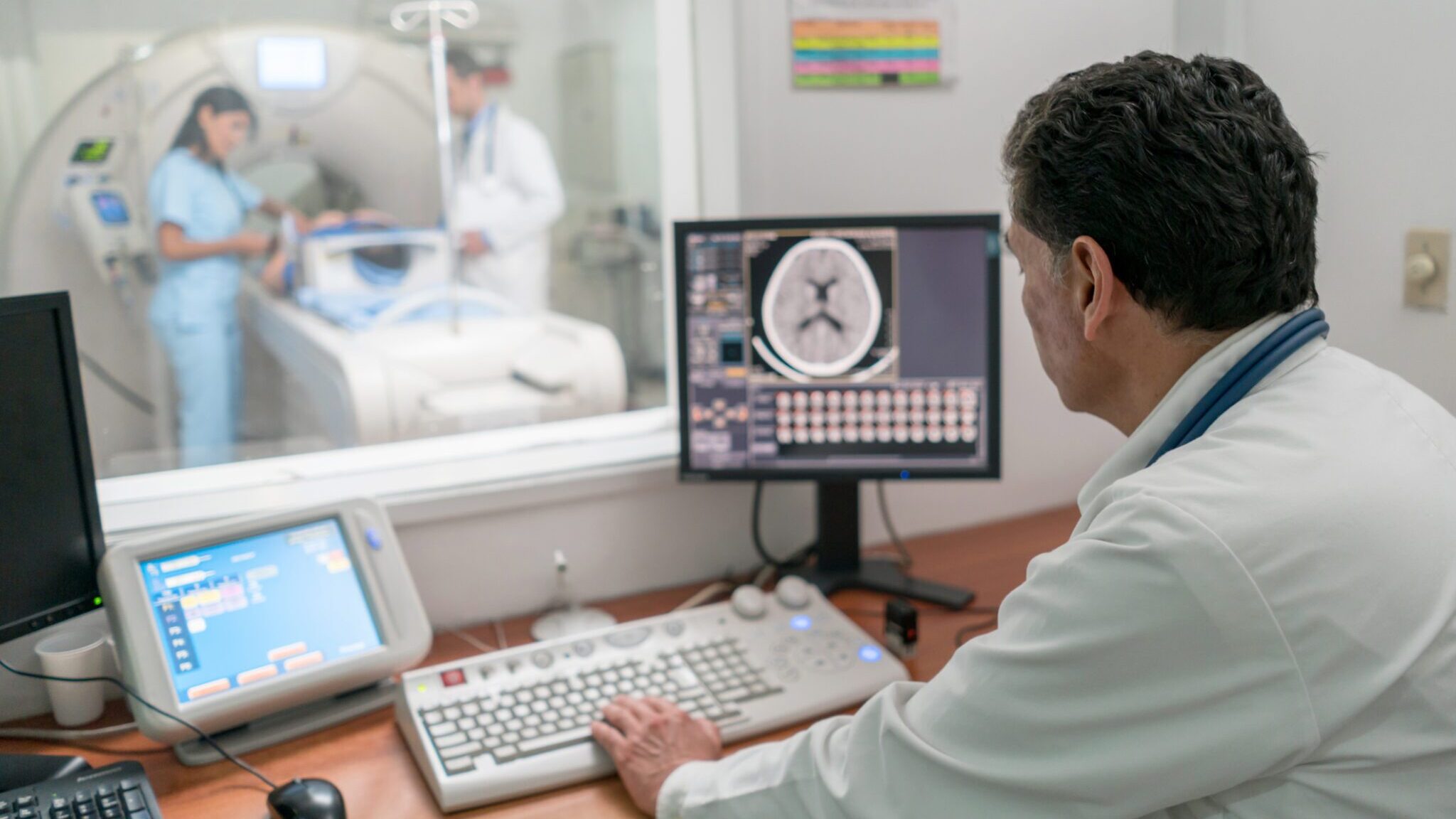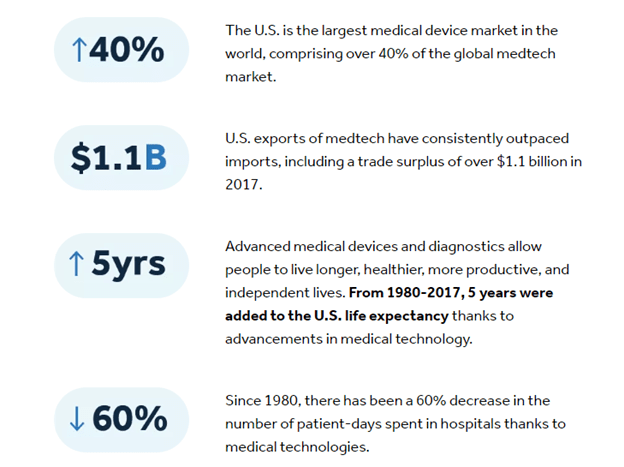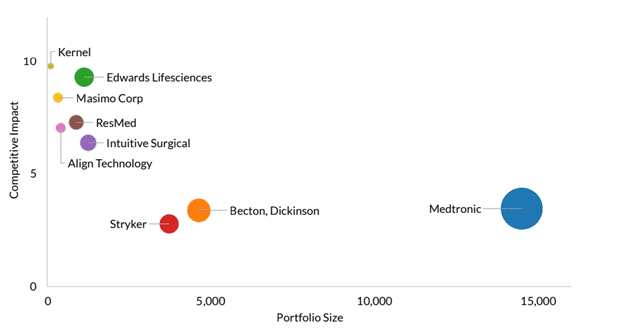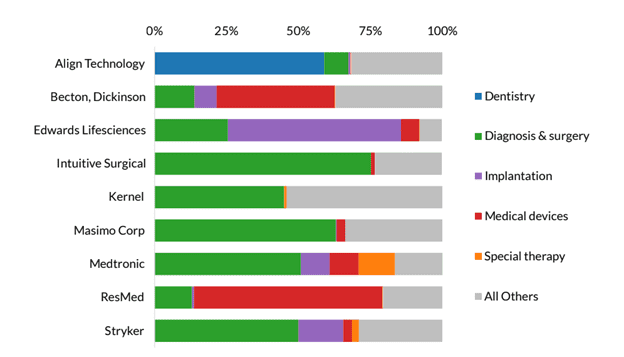Innovation in Medical Technologies: Highlighting the Top Companies

People worldwide are living longer. Every country in the world is experiencing growth in both the size and the proportion of older persons in the population. By 2030, one in six people around the world will be aged 60 or older, according to the World Health Organization, with the global population of people aged 60 and older doubling by 2050. The reason people are living longer and in greater numbers can partly be attributed to developments in areas such as diagnostics and monitoring, life support systems, surgery, and emergency care—innovation in Medical Technologies.
According to the Advanced Medical Technology Association “The Medical Technology industry—often referred to as medtech—comprises the companies that develop, manufacture, and distribute the technologies, devices, equipment, diagnostic tests, and health information systems that are transforming healthcare through earlier disease detection, less-invasive procedures, and more effective treatments.”
The U.S. dominates this industry according to the findings from the recently published industry report “Innovation Momentum 2023: The Global Top 100”, which leverages LexisNexis® PatentSight® patent data to measure the dynamics of technology development over the past two years and identify fast-paced innovators across industries. In the Medical Technology industry, all of the companies increased the size of their patent portfolios, even if only slightly, and managed to maintain or improve the average quality of their patent portfolios. The underlying method of the report is based on the Patent Asset Index, an industry-trusted measure that uses a scientifically validated method to evaluate the innovative strength of a patent portfolio. This approach of measuring the innovation momentum that companies were able to generate, offers an objective way of identifying companies that have surpassed their competitors in developing a qualitatively superior patent portfolio in the previous two years.
While the growth of their portfolios and their geographical location mostly unites these companies, the players in this industry diverge considerably when it comes to their innovation in Medical Technologies. This, after all, is an industry that touches a wide variety of technologies, from electronics and computing power to miniaturization, enabling the development of implantable devices.
Innovation in Medical Technologies
Medical devices impact our day-to-day lives with devices such as eyeglasses, contact lenses, and bandages. Medical devices that are needed only from time to time for most of us include diagnostics, monitoring, life support systems, surgery, and emergency care. Examples of innovation in Medical Technologies that have had very positive impacts on patients include glucose monitoring and insulin delivery systems for diabetics, and cardiac implantable electronic devices, such as pacemakers, implantable cardioverter defibrillators (ICD), biventricular pacemakers, and cardiac loop recorders, for patients with cardiovascular disease. As noted in the chart below, advances in medical devices and diagnostics have improved life expectancy in the U.S.
The Advanced Technology Medical Association reports that innovation in Medical Technologies has resulted in:
Overview of top Medical Technology companies
The “Innovation Momentum 2023: The Global Top 100” identifies nine Medical Technology companies that have increased their portfolio size and maintained or improved the average quality of their patent portfolios. The top Medical Technology companies include:
Align Technology: an American global medical device company that is reimagining and reinventing the way orthodontic and restorative treatment is presented and delivered.
Becton, Dickinson: one of the largest global medical technology companies in the world, based in the U.S., that works to improve medical discovery, diagnostics, and the delivery of care.
Edwards Lifesciences: a U.S. company and a global leader in patient-focused medical innovations for structural heart disease, as well as critical care and surgical monitoring.
Intuitive Surgical: an American corporation that develops, manufactures, and markets robotic products designed to improve clinical outcomes of patients through minimally invasive surgery.
Kernal: founded in the U.S., the company has built technology for noninvasively measuring the brain with the goal of making precision neuroscience the standard.
Masimo Corporation: a U.S.-based global medical technology company that develops and produces a wide array of monitoring technologies, including measurements, sensors, and patient monitors.
Medtronic: the American company now headquartered in Dublin, Ireland, is a global producer of medical devices and therapies, such as insulin pumps, pacemakers, and diabetes therapies.
ResMed: a U.S based company that produces cloud-connected medical devices that transform care for people with sleep apnea, COPD and other chronic diseases.
Stryker: an American medical technology company that offers products and services in medical and surgical, neurotechnology, and spine that help improve patient and healthcare outcomes.
Analysis of Medical Technology companies
Medtronic owns the largest patent portfolio and is the strongest according to the Patent Asset Index, The company has also significantly increased its patent portfolio while maintaining average patent quality, their innovation in Medical Technologies enables everything from digital diabetes monitoring to minimally invasive surgery and tiny leadless pacemakers that can be implanted directly into the heart.
Medtronic is a global producer of medical devices that served 76M patients in 2022. The company’s innovation in Medical Technologies treats over 70 health conditions. Medtronic has four major reporting segments including cardiac and vascular, minimally invasive therapies, restorative therapies, and diabetes. The cardiac and vascular segment is the largest and makes devices like pacemakers and defibrillators. The company has almost 50K active patent families.
Masimo Corp. develops and manufactures innovative noninvasive patient monitoring technologies. The company developed the Signal Extraction Technology® (SET®) that uses five parallel processing engines that measure oxygen saturation, pulse rate, respiration rate, total hemoglobin, and other clinically valuable measurements. Masimo has a small portfolio with one of the highest average patent quality increases in the industry.
Align Technology is reinventing the way orthodontic and restorative treatment is presented and delivered. The company uses scanners, 3D computer modeling, and additive manufacturing to scale up production while customizing products for individual patients. By focusing on one type of device, it has been able to improve its average patent quality on a consistent basis.
The chart below shows the average patent quality (Competitive Impact) versus the portfolio size of patent owners in the Medical Technology industry sector. The bubble size of the patent owners represents the portfolio strength as measured by the (Patent Asset Index).
This chart shows the major technology fields covered by the innovators in the Medical Technology industry sector as a share of the patent owners’ portfolio.
The importance of innovation in Medical Technologies during a pandemic
The COVID-19 pandemic put a great strain on health care systems and created high demand for certain types of medical devices, including personal protective equipment, diagnostic testing, respirators, and ventilators to name a few. There were frequently shortages of medical devices needed to diagnose and treat patients.
Some inventions become more important as new challenges, such as a pandemic, arise. For example, the ventilator technology invented by ResMed used in the production of medical devices for respiratory disorders, such as sleep apnea, became more relevant at the height of the COVID-19 pandemic. This development likely explains the increase in ResMed’s average patent quality.
The Medical Technology industry is a vital contributor to global health
Innovation in Medical Technologies has improved life expectancy by making healthcare more accessible and developing better diagnostic tools leading to higher accuracy in diagnostics. Enhanced monitoring tools, including wearables, and more sophisticated life support systems have also improved life spans. Medical devices have created more efficiency by automating tasks, creating electronic health records, providing online portals to connect patients with health management tools and medical records, and allowing patients to communicate electronically with their medical professionals.
The Medical Technology companies identified in the “Innovation Momentum 2023: The Global Top 100” report are leading development in medical devices to provide more accurate diagnosis and monitoring, robotics to improve outcomes through minimally invasive surgery, insulin pumps and diabetes therapies, pacemakers, noninvasive brain measuring, and much more. As the world’s population continues to age and live longer, the need for continued innovation in Medical Technologies is critical.
The second edition of the Innovation Momentum report reveals that this is an exciting time for the world’s innovators. Driven by global trends innovation is coming from a broad range of industries. The pace of the technological revolution continues to accelerate, providing opportunities for companies of all sizes. Using the Patent Asset Index to make sense of vast amounts of global patent data, the Innovation Momentum methodology makes it possible to track these developments and, through sophisticated patent analytics, to provide a window into the most important scientific and technological advances of our time. Download the report now.

Which companies are pioneering the future of science and technology?
Download Innovation Momentum 2023: The Global Top 100 to find out! Using our proprietary patent quality metrics to look at the global patent landscape we list out the Top 100 innovators worldwide. Read the full report to discover which companies are at the forefront of innovation, driving future technologies.



